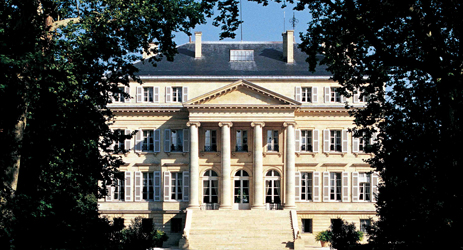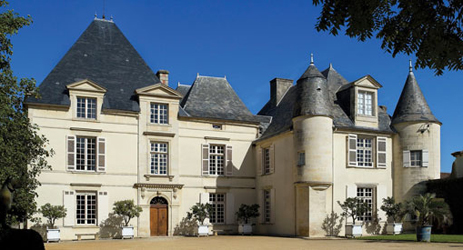3rd Cru Classe, 1855
33460 Margaux
+33 (0)5 57 88 90 82
www.boyd-cantenac.fr

Location: AOC Margaux, in the commune of Cantenac.
Production: 17 hectares, producing an average of 50,000-90,000 bottles per year, split approximately two-thirds first wine and one-third second wine.
Five things you didn't know about Chateau Chateau Boyd-Cantenac:

- Chateau Boyd-Cantenac is one of 14 chateaux in Bordeaux bearing an Irish name, testament to the huge wave of emigration from Ireland to France in the 17th and 18th centuries. Among the famous Bordeaux names with Irish heritage are Boyd, Barton, Clarke, Kirwan, Phelan, Lynch and Lawton.
- One of the smaller classified estates in Margaux, it has one of the most limited distributions in Bordeaux, making it less visible on international markets than many of its third growth neighbours.
- The number of vineyard workers at Boyd-Cantenac are doubled from May to July, and quadrupled during the harvest period.
- The Guillemet family has owned Boyd-Cantenac since the 1930s, but one of Lucien Guillemet’s ancestors in 1830 bought part of the then-bankrupted vineyard of Brown (today Cantenac Brown), so they have been in the Margaux appellation for almost 200 years.
- At the time of the 1855 classification, the estate was simply known as Chateau Boyd. Its vines have since been split into Cantenac Brown and Boyd-Cantenac.
Current owner: The Guillemet family, with Lucien Guillemet as managing director and winemaker
Most notable previous owner: As they reportedly fell out in real life, it seems a shame to choose between Jacques Boyd and John Lewis-Brown, both key owners of the chateau in the 18th and 19th centuries.
Other chateaux owned: Chateau Pouget, another classified wine estate in Margaux (which for many years was integrated into Chateau Boyd-Cantenac but since 1983 has been fully separate). This was bought by Lucien Guillemet’s great grand-father in 1906.
Commercial strategy: Sold en primeur (in wine futures) six months after vintage, largely through négociants but with exclusivities. They also sell some of the wine direct to restaurants.

Second wine: Jacques Boyd (created in 1997).
Through the centuries:
The Boyd family, successful merchants from Belfast, first made their money in sheep farming – or more specifically as wool merchants. But as the wool trade became mired in protectionist tariffs from the English, and so began to die out in Ireland, James Boyd moved his family over the Channel in 1745, where he was made a noble by King Louis XV, and became known as Jacques as he increasingly adapted to life in his adopted country. In August 1754, he bought the lands of Bernard Sainvincens in Cantenac, and created Chateau Boyd Cantenac.
Half a century later, and the ownership passed to the Scottish John Lewis Brown (who gave his name to both Chateau Brown in Pessac Léognan and Cantenac Brown in Margaux), when he married in to the Boyd family in 1806. The chateau was known simply as Boyd in 1855 (by which time it was owned by a consortium), when it was named as a Third Growth, but was later split into Boyd Cantenac (from Jacques Boyd) and Cantenac Brown (from John Lewis Brown).
The Boyd Cantenac part was later owned by the ubiquitous Ginestet family for the early part of the 20th century, when they owned or administered numerous estates including Chateau Margaux, but it was one of the first of the Ginestet chateaux to leave their hands when they were hit by economic crisis of the 1930s. In 1932, Boyd Cantenac was bought by Pierre Elies, already owner of neighbouring Chateau Pouget and great grandfather of the current owner, Lucien.
Consultant: There is no external consultant at this estate; owner Lucien Guillemet is a trained oenologist and winemaker (this is very unusual, as only a handful of classified estates have no external consultants – one notable case being Chateau Haut-Brion).
Plantation and vineyard work: Cabernet Sauvignon (60%), Merlot (25%), Cabernet Franc (8%), Petit Verdot (7%), planted to 10,000 vines per hectare, with an average age of 38 years. The vines are farmed with no chemical fertilisers, which haven’t been used since the 1960s.

Vinification: Cement and stainless steel vats (from 50 to 150 hectolitres) emphasise the fruit – and this is known for being a wine that tastes very appealing and approachable from a fairly early age compared to some of its Médoc peers. Malo-lactic carried out partly in barrel, partly in vat, then all the wine is moved into barrels for ageing in French oak for between 12-18 months depending on vintage. The wine has fairly high percentages of both Petit Verdot and Cabernet Franc, giving it a distinct character that combines richly spicy fruit, a deep colour, with high aromatics.
Terroir: Silex and gravel, with great drainage, given warm soils that allow for deep roots.
Recent improvements or changes:Since Lucien Guillemet took over from his father Pierre Guillemet in 1996, the wine has deepened in power and complexity, after some years of under-performing in the 1980s and 90s. Today it represents excellent value for money in Margaux, although still flies way under the radar.
Recent Decanter scores:
2012 en primeur – 17 points/20
2011 en primeur – 17 points
2010 en primeur – 17.5 points
2009 en primeur – 17.5 points
2008 en primeur – 17 points
Average bottle price in UK: £30-£40.
All rights reserved by Future plc. No part of this publication may be reproduced, distributed or transmitted in any form or by any means without the prior written permission of Decanter.
Only Official Media Partners (see About us) of DecanterChina.com may republish part of the content from the site without prior permission under strict Terms & Conditions. Contact china@decanter.com to learn about how to become an Official Media Partner of DecanterChina.com.




Comments
Submit